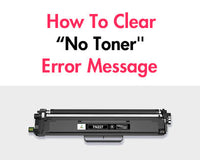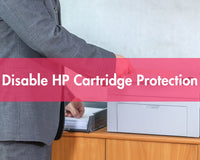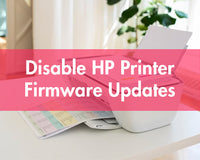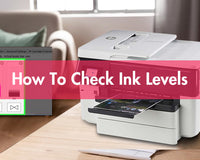Imagine you're about to print an important document, but when you hit "Print," the page is streaked or blank. This common situation is usually caused by the printer ink drying up. Understanding why this happens and how to prevent it can save you time, money, and a lot of headaches. In this blog, we'll dive into the topic of "Does printer ink dry out?" and reveal the reasons why ink dries up.
Quick Summary
Printer ink is a liquid substance that will dry out over time, especially if the printer is not used regularly. This drying process occurs as the solvent in the ink evaporates, leaving behind pigments or dyes that can clog the printer's nozzles. The design of the ink cartridge and the environmental conditions in which the cartridge is stored can also have a significant impact on how quickly the ink dries.
In general, to prevent your printer ink from drying out: For unopened cartridges, keep them sealed and store them at a comfortable temperature; for cartridges that have already been used in the printer, it is best to use the printer regularly to print to keep the ink flowing. If your printer's ink cartridges have dried out, you will need to use the automatic cleaning function or manually clean your cartridges and printheads.
What is Printer Ink?
Printer ink is a complex formulation that usually consists of a dye or pigment suspended in a liquid carrier. The main ingredients include:
Dyes and Pigments:
These are colorants. Dyes are dissolved in a liquid medium, while pigments are particulate solids suspended in the ink. Dyes generally provide more vivid colors, but pigments provide better durability and resistance to fading.
Solvents:
These liquids keep the ink fluid, facilitating smooth flow of the ink through the printer's nozzles. Common solvents include water, ethylene glycol, and alcohol.
Additives:
These include substances that improve the ink's properties, such as anti-clogging agents, surfactants, and stabilizers.
Types of Printer Ink
The two main types of printer ink are dye-based and pigment-based inks:
Dye-Based Inks: Dye inks are known for their vibrant colors and are commonly used in consumer-grade printers. Dye inks are less expensive, but they fade and smudge easily.
Pigment-Based Inks: These inks offer improved durability and water resistance, making them ideal for professional printing and archival purposes. However, they tend to be more expensive than dye inks and have duller colors.
Specialty Inks: Includes sublimation inks, which are used to transfer images onto fabrics, and archival inks designed for longevity and fade resistance.
Why Does Printer Ink Dry Out?
There are several reasons why printer ink dries up, mostly related to the ink being exposed to air, which causes the ink to evaporate and undergo chemical changes. Here are the main factors that cause ink to dry up:
Exposure to Air: When a cartridge is exposed to air, the solvents in the ink evaporate, leaving behind solid pigments and resins that can clog the printhead nozzles. This exposure can happen if the printer has not been used for a long time or if the cartridges are not properly sealed.
Temperature and Humidity: High temperatures speed up the evaporation of the ink solvents. Low humidity environments also cause faster drying because the air draws moisture away from the ink.
Printhead Design: Some printers have printheads integrated into the cartridge, while others have separate printheads. Both types of printers can dry out if not used regularly, but the built-in printheads in the cartridges may be more likely to dry out if left idle for long periods of time.
Frequency of Use: Infrequent use of the printer can cause the ink in the nozzles to dry out. Regular printing helps keep the ink flowing and prevents the ink from settling and drying out.
Cartridge Design and Quality: The design and quality of the cartridge can affect how well it prevents the ink from drying out. High-quality ink cartridges usually have better seals and more efficient storage mechanisms to prevent the ink from drying out.
Leaving Cartridges Out: Removing the ink cartridge and leaving it exposed without properly sealing it will cause the ink to dry out quickly.
What Happens When the Ink Dries Up?
When printer ink dries, the solvent evaporates, leaving behind a solid residue of dye or pigment. This residue can clog the tiny nozzles in the print head, preventing the ink from flowing smoothly, resulting in poor print quality. In severe cases, the dried ink can render the cartridge unusable and require replacement.
How to Keep Printer Ink from Drying Out
To extend the life of your printer ink and maintain optimal print quality, it is important to follow some best practices.
Store Ink Cartridges Properly
Proper storage of cartridges is essential to prevent premature drying.
Keep Cartridges Sealed: Store unused ink cartridges in their original packaging until you are ready to use them. This helps prevent the ink from drying out due to exposure to air. After opening, try to keep the ink cartridges in an airtight container to minimize contact with air.
Optimal Temperature and Humidity: Store ink cartridges in a cool, dry place away from direct sunlight and heat. The ideal storage temperature is 59°F to 77°F (15°C to 25°C). High temperatures speed up the evaporation of solvents, while extreme cold causes the ink to thicken. Also, maintaining moderate humidity helps prevent the ink from drying out too quickly.
Upright Positioning: Store ink cartridges upright to prevent leakage and ensure that the ink remains in contact with the nozzles. This placement helps maintain a consistent ink flow when the cartridge is installed in the printer.
Use Your Printer Regularly
Using your printer regularly is one of the best ways to keep the ink flowing and prevent it from drying out.
Frequent Printing:
Even if you don't print often, try to print a page or two every few weeks. This practice helps prevent the ink in the cartridges from settling and drying out. Using color ink occasionally can prevent individual colors from drying out, because some printers have separate cartridges for each color.
Automated Cleaning Cycles:
Many modern printers have built-in maintenance routines to clean the printhead and prevent clogging. These automatic cycles can usually be scheduled or manually activated through the printer's settings or software. Make sure to enable and use these features regularly, especially if the printer is idle for long periods of time.
How to Fix Dry Printer Ink
If your printer has run dry, you can try to revive it by cleaning the ink cartridges and printhead before replacing them.
Print Head Automatic Cleaning Function
Most modern printers come with an automatic cleaning feature that can help resolve minor clogs and improve print quality. This feature uses a combination of suction and ink flow to clear dried ink from the nozzles.
Access the Printer's Menu: First, use the printer's control panel or the included software to access the Maintenance or Setup menu.
Select the Cleaning Option: Look for an option labeled "Clean Print Head," "Maintenance," or something similar. This feature may have multiple intensity levels, such as basic cleaning and deep cleaning.
Run the Cleaning Cycle: Click “OK” to start the cleaning process such as “Nozzle Check” and follow the on-screen instructions. This process may take several minutes and consume some ink, but it can effectively clear minor clogs.
Print a Test Page: After the automatic cleaning is finished, print a test page to check the print quality. If the problem persists, you may need to run the cycle again or try a more thorough cleaning method such as a deep clean.
Our blog How to Automatically Clean HP Printer Cartridge explains the process of automatic printhead cleaning in detail.
Manual Cleaning
When automatic cleaning isn't enough, manual cleaning may be necessary. This requires a more hands-on approach to unclog the printhead and restore ink flow.
Remove the Cartridges:
First, carefully remove the ink cartridge from the printer to avoid damaging the printer or the ink cartridge.
Prepare a Cleaning Solution:
Then, use distilled water or a specialized cleaning solution designed for inkjet printers. Avoid using tap water, as it may contain impurities that could cause further clogs. You can find these cleaners online or at office supply stores.
Clean the Print Heads:
Dampen a lint-free cloth or cotton swab with the cleaning solution. Gently wipe the printhead, focusing on areas where the ink has dried. Be careful not to use too much force, as this may damage the printhead. For stubborn clogs, let the cleaning solution sit on the printhead for a few minutes before wiping.
Soak the Cartridges (if necessary):
If the nozzles are badly clogged, you can soak the print head in cleaning fluid. Place the print head in a shallow dish with the nozzles facing down and let it sit for 10-30 minutes. This will help dissolve the dried ink. After soaking, wipe the print head dry with a clean cloth and reinstall the ink cartridge.
This blog post How to Clean HP Printer Heads details how to manually clean your print heads and ink cartridges.
If the cleaning attempts fail and print quality remains poor, your printer ink cartridge might need to be replaced. True Image offers great compatible printer ink cartridges at low prices, such as HP 67XL, HP 902, HP 910XL, Brother LC401, Canon 280 281, Epson 812, etc. These ink cartridge replacements have great page yields and excellent print results. Free Shipping on Orders Over $30 & Lifetime 100% Satisfaction Guarantee.
Tips
For users who print infrequently, consider other solutions to avoid the hassle of dealing with dried ink:
Switch to a Laser Printer
Laser printers use toner, a powder that doesn't dry out like liquid ink. This makes them a great choice for infrequent printing. Brands such as Brother offer cost-effective monochrome laser printers, while Canon and HP offer high-quality color laser printers. Read Canon vs HP Printer: Which to Choose to learn more about the color capabilities of Canon and HP printers. Laser printers generally have a higher initial cost, but operating costs decrease over time, making them a good investment for users with low to moderate printing needs.
Find an Outside Printing Service
If you print less than ten times a year, it may be more economical to use an outside printing service, either at a local store or online. This approach eliminates the need to maintain the printer and ink, saving you time and money. Many services offer convenient pickup and delivery options, as well as a variety of printing capabilities, from standard documents to high-quality photo prints. Check out I Don't Have a Printer Where Can I Print for more information.
Conclusion
Printer ink does dry out, leading to frustrating printing problems. However, by adopting the right storage and maintenance practices, you can significantly extend the life of your ink cartridges. For those who print infrequently, it may be more cost-effective and convenient to consider alternatives such as laser printers or external printing services.












